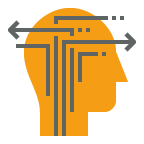With every webpage loaded, email sent, or video streamed, network traffic takes a complex journey…
When asked what Exoprise does we often say, “Network Intelligence for Application Owners”. Sometimes that will spin up a more involved conversation and more details about the state of Enterprise networks and cloud adoption. It depends on how knowledgeable a person is — sometimes their eyes will quickly glaze over and we’ll part ways. 😉
 Let’s dive deeper into what ‘Network Intelligence for Application Owners’ means and why its critical.
Let’s dive deeper into what ‘Network Intelligence for Application Owners’ means and why its critical.
What’s Hot Is Outside the LAN
We’ve said this plenty of times before but the shift to cloud computing and adoption of services like Salesforce, Office 365, Service Now and AWS/Azure is huge and growing. With this shift comes the increased importance of network visibility and intelligence. Most of what’s important and new is happening on the outside of the legacy LAN & WAN — out in the cloud — beyond the reach and visibility of traditional network tools and beyond the reach of traditional network intelligence.
If your teams are solely relying on internal router packet loss and latency measurements for monitoring the health of your Office 365 deployment, you’re missing the point (or the packets!). You need tools that will help you understand the network end-to-end including what’s going on OUTSIDE as well as INSIDE. You need to understand end-user experience for monitoring SharePoint Online, Exchange Online, Onedrive, Skype for Business Online and more. And often, the experience is affected by cross-server, cross network boundaries where you’re not going to have to the whole picture from backend server monitoring or network device capture.

Hop-by-Hop Data, ICMP required
We work with customers, specifically Application Owners, that ask us why they don’t see any metrics for hop-by-hop data beyond the gateways or sometimes even internal hop data. Well that’s because their Network Administrators have blocked or disabled inbound-ICMP. They may do this across all the control messages when they don’t have to. This is short-sighted and may have been a best practice in the days of when everything was happening behind the firewall, internally. Its old school and its one example of the Network Administrators not sharing their “tools”.
You have to enable some level of inbound-ICMP for application owners to be able to see if there are problems with the Service Delivery Chain, the ISPs, the Network Providers and the Internet on the whole. If your network can’t handle the periodic ECHO REPLY, ECHO REQUEST or TIME EXCEEDED traffic (packets for tracing and pinging from within your firewall), then your network probably isn’t ready for adopting the cloud and its time to step it up.
Network Administrators Don’t Share Their Monitoring Tools
There are more examples of network admins not sharing their tools and why we specifically created our CloudReady solutions for Application Owners.
Application Owners and IT Architects are the people responsible for adopting the cloud service, migrating to it, rolling it out, and making sure it’s accessible and working for everyone. When it comes to something like Salesforce or Office 365 – these are the guys and gals that are on the hook if anything goes wrong with the service.
Application Owners, while responsible for the safe adoption of cloud applications, often don’t have access to the tools and network insight that is necessary for ensuring the success of a cloud deployment. This is bad. Exoprise has seen a few reasons for this:
- Licensing issues – sometimes the legacy network management tools are licensed per user so there’s a finite number of users allowed. CloudReady doesn’t work this way, we operate on a per-application basis.
- Permissions – often with legacy tools, visualization isn’t segregated from control. When this is the case, network admins don’t want to give control of the network to application owners that just might want to see visualizations of the network performance for Office 365.
- Information Overload – there’s lots of low-level details in TCP/IP networking. Flow rates, BGP, DNS lookups, RTT, packet loss, routing and more. Many network management tools operate at a lower-level then what’s suitable for a general understanding of the end-user experience of cloud apps. Check out this diagram for the low-level TCP/IP packet details.

Network Intelligence For Application Owners
CloudReady was born-in-the-cloud and is the right tool for the right job — ensuring mission-critical cloud applications and their dependencies are accessible from everywhere and performing well. Application Owners and IT operations teams are on the hook when a cloud application is having problems just as they were when they had access to all the dials and telemetry from on-premises systems.
With CloudReady, Application Owners can instantly see the end-user experience in real-time, often before the user experiences a problem, with hop-by-hop diagnostics for troubleshooting and long-term trending for Service Level Management. And they can easily share those tools to whoever needs them.
“Share your knowledge. It is a way to achieve immortality.”
— His Holiness the Dalai Lama


